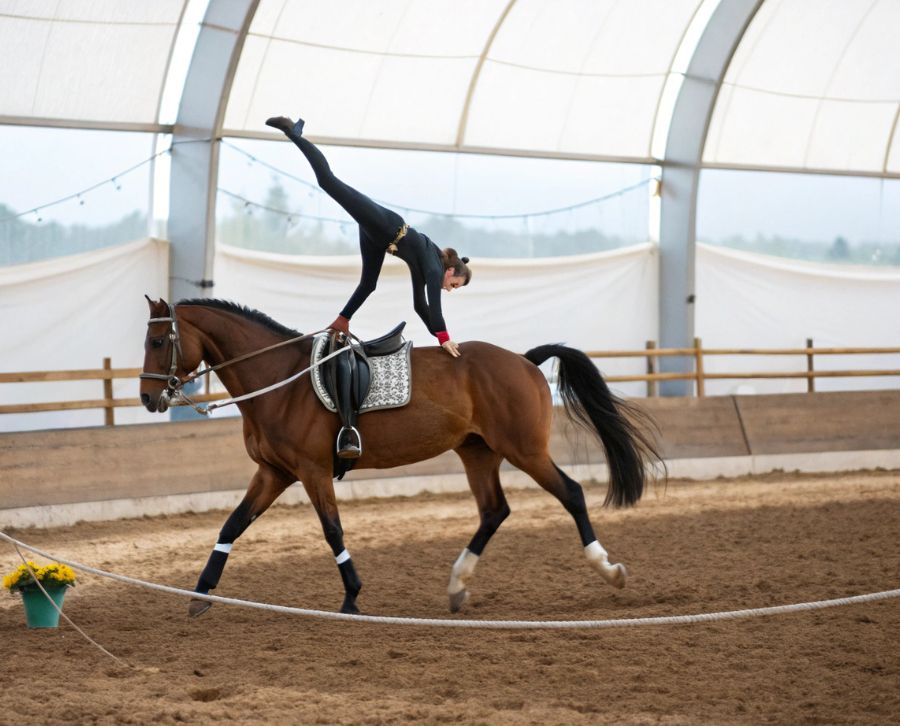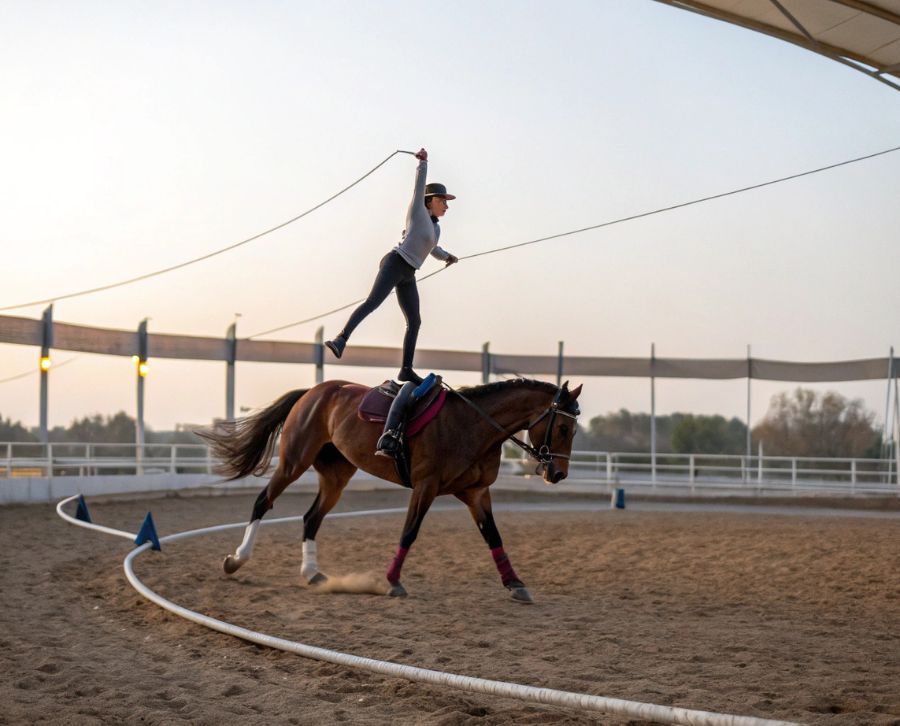Have you ever seen a horse show where the rider did pirouettes and gymnastic exercises on the horse? For example, doing somersaults or changing from one side of the animal to the other without letting go of the rope… The answer is probably yes, and this discipline is known as tumbling on horseback. One of the most risky and colorful practices in the equestrian world.
From Equspaddock, as manufacturers of equestrian equipment, in this article, we tell you what this modality consists of, what type of stunts are performed, how to practice and much more.
Surprise yourself and learn more about the possibilities of this animal world!

What is horseback vaulting and what does it consist of?
Equestrian vaulting is a discipline that combines acrobatics, gymnastics, dance and balance with elegance, balance, strength and coordination between horse and rider. In this modality, the vaulters (riders) perform pirouettes and acrobatics on the animal while it trots and gallops on a circular track guided with a long rope at a constant and fast pace.
Furthermore, this discipline can be done individually or combined, performing exercises between several riders and horses at the same time. This is how you can perform different postures, jumps, balances, acrobatics… It is one of the competitions that requires the most involvement and level.
It takes great confidence, body control and great synchronization between rider and horse.
History and origin of equestrian vaulting
This equestrian discipline originated in ancient Rome where it was practiced in the military to prepare soldiers for war and the most demanding combats. Later it was also practiced among the nobility as a recreational activity.
As time went by, in 1983, the FEI (International Equestrian Federation) considered it an official sport along with regulations that have made it one of the most demanding modalities and is practiced worldwide.
Differences between horse vaulting and other equestrian disciplines
Although this discipline shares some features such as precision, high demands or great trust between the pairing and other modalities such as dressage or jumping, for example, it is a unique and very characteristic sport.
The great differentiation with the rest of the equestrian disciplines is that the main activity does not focus on the animal and its direction, but on the acrobatics and pirouettes that the rider performs on it.
Furthermore, it is done in a circular circuit, neither stirrups nor reins are used and great balance and a lot of trust is required between both.
Characteristics of equestrian vaulting and its importance
As we have mentioned, vaulting in horseback riding stands out for the great relationship between rider and horse. Therefore, the training of one and the training of the other is important. This takes a lot of time, effort and perseverance. Furthermore, given its demand, it is not a modality suitable for all lovers of the equestrian world or for all horses.
Dumping horses: requirements and characteristics
Among the vaulting horses, breeds such as the Arabs, the Spanish crosses, the Fjord, the Percheron or the Dutch horse stand out. These must be calm specimens, with great precision, obedient and confident in the movements they make.
It is essential that they do not get scared when performing movements on them, that they endure a constant trot and that they are strong to provide stability to the rider.
Necessary equipment for the practice of horseback riding
The accessories and equipment for horseback riding are:
- Bridle with fillet or winding (specific for this modality)
a blanket to protect the animal’s dorsal
turning strap to be able to do the maneuvers
fixed reins
long rope
Protectors
Bandages
Flexible footwear that allows the rider to move quickly.
Basic techniques and movements in horse vaulting
Do you want to know what the most common movements are in this equestrian sport? Vaulting in equestrian requires great precision, confidence and technical knowledge to perform agile maneuvers and unique acrobatics.
Fundamental positions in the discipline
Among the basic positions of horse vaulting are:
Basic seat. The tumbler sits with both legs facing the same side.
Flag passing. The rider places one foot on the horse’s back and extends the other foot backwards.
Windmill. The turner turns on the back of the ballo only holding on to the handles of the cinchón or cinchuelo.
Iron. It consists of lying face down on the horse’s back completely.
Knees. The vaulter kneels on the girth with his back straight and arms extended.
Balance and coordination exercises for equestrian vaulting
Once the basic tumbling movements are performed with precision and agility, the tumblers perform other more complicated pirouettes. For example:
Jumps on the moving horse.
Spins in the air while the animal gallops.
Several vaulters perform acrobatics on the back of a single horse.
One vaulter throws another up and the latter has to land precisely on the horse’s back.
Human pyramids or geometric figures.
Benefits of horseback riding for riders and horses
These types of exercises require a lot of practice, since both the animal and the rider must have strength, precision and security in each movement. Therefore, it is essential to carry out safe, constant and very varied training. In this way, both come together and achieve both emotional and physical benefits.
Improved coordination, strength and flexibility
The balance of the vaulter on the horse’s back is developed, the strength of both the animal and the rider is improved, and concentration and confidence between them is encouraged. In this way, a very special relationship is generated, ideal for this and many other equestrian modalities.
How to start in equestrian vaulting? Beginner’s Guide
If turning in horse riding catches your attention or if you do another modality and you are interested in trying this one, it is interesting that you ask at your equestrian center (or those close to you, if you have never practiced horse riding) to make sure that they offer this modality. It is true that, as advice, if you have not ridden a horse before, practice another type of modality beforehand.
Equestrian centers specialized in horse vaulting
It is essential that the center has vaulting horses with a temperament and character suitable for this type of exercises and activities. At the same time, it must have the necessary equipment and facilities. Ask those closest to you and find out about the possibilities they offer you.
Tips for choosing a suitable vaulting horse
When choosing a vaulting horse you must keep in mind that it has to be calm, strong, resistant, obedient and confident. In this modality, trust, balance, precision and teamwork are essential.
What are the main rules in equestrian vaulting competitions?
Equestrian vaulting is one of the most demanding disciplines since it demands a lot of concentration, confidence, prior work, understanding and skill. Therefore, we recommend that you also take into account the regulations of the FEI (International Equestrian Federation) and the RFHE (Royal Spanish Equestrian Federation) that regulate this discipline at a technical level.
For example, among the most notable standards are:
The horse must be at least five years old and must be registered with a federal license. It must move with a minimum diameter of 15 meters. Before starting the exhibition, it is evaluated to check whether it is suitable or not.
It is essential to use the equipment of this modality: bridle with snaffle, long rope, whip, protectors, turning belt with handles…
The judges evaluate the balance, fluidity, synchronization, behavior of the animal…
There are many more rules that must be taken into account in this discipline. Without a doubt, it is one of the most striking in the horse world. Discover it and enjoy horses in a different way!



